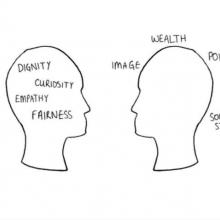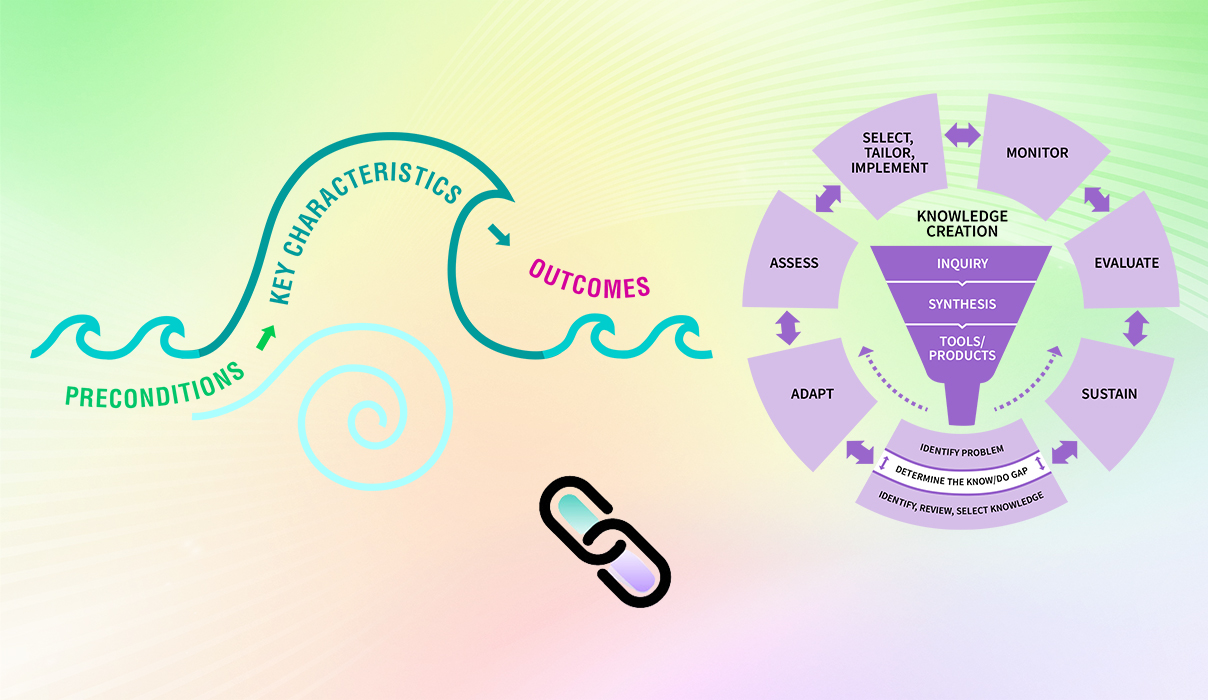Intrinsic motivation
- Intrinsic motivation
- 1 What is this element?
- 2 Why is this element important?
- 3 Considerations for getting started
- 4 Case studies
- 5 Strategies to foster intrinsic motivation in change agents
- 6 Implementation tools
- 7 Navigating common problems
- 8 Check your progress
- 9 Linking this key characteristic to other framework components
- 10 More resources
Index
- 1. What is this element?
- 2. Why is this element important?
- 3. Considerations for getting started
- 4. Case studies
- 5. Strategies to foster intrinsic motivation in change agents
- 6. Implementation tools
- 7. Navigating common problems
- 8. Check your progress
- 9. Linking this key characteristic to other framework components
- 10. More resources
In the context of evidence uptake and sustainability, another key characteristic of social movement action is the presence of intrinsically motivated change agents who are committed to the shared concern or strongly desired change and are ready to take action. In this section, you will learn more about the central role of intrinsic motivation for change agents engaged in social movements and some techniques to inspire this type of motivation in others.

What is this element?
- individuals take action because of "free choice" or autonomy; they thrive on the experiences associated with getting involved, and building and expanding personal capacities
- individuals are "moved" by something (for example, an issue, concern, or cause) and voluntarily find ways to take action
- individuals set goals for themselves that reflect their personal values and in doing so, also support their psychological needs of:
- autonomy (having choice and control over what we do)
- mastery (the drive to build competence and self-improvement)
- greater purpose (by connecting with others who share similar goals)
SOURCES: Ben-Hur and Kinley, 2016; Ryan and Deci, 2000.
Remember: Intrinsically-motivated individuals engage with a change initiative because they want to – and because they care about the issue.
Intrinsic motivation can be driven also by a yearning to change issues in context – small or big – for the better through individual and collective action that engages people creating emotional bonding and collective identity (Serna Restrepo, et al, 2018). Examples of expressions of intrinsically-motivated individuals in the context of work include: deriving pleasure from learning new things, experiencing satisfaction with taking on interesting challenges or feeling satisfied after accomplishing difficult tasks (Tremblay et al., 2009).
Other forms of motivation
Extrinsic motivation is tied to ego and a need to feel significant or important (Ryan and Deci, 2000). It relies on external incentives or rewards, prodding or pressure from others, or fears of punishment. Examples of expressions of extrinsically motivated individuals in the context of work include the fact that the work is a means to earn money, or a source of security or status (Tremblay et al., 2009).

Caption: Intrinsic versus extrinsic motivation
Amotivation, at the lowest end of the motivation continuum, is tied to a lack of action. People who are amotivated either act passively or lack the intention to take any action. Examples of expressions of amotivation in the context of work include: lacking a rationale for choosing a type of work, feeling that the working conditions are unrealistic, or feeling that too much is expected of workers (Tremblay et al., 2009).
"To be motivated is to be moved to do something." (Ryan & Deci, 2000)
Why is this element important?
By using sources of intrinsic motivation, individuals are more likely to engage as change agents or members of a change team because they personally value the shared concern or desired change and want to address it. The experiences of being a part of a change are seen as meaningful, with a sense of responsibility and pride in the results achieved.
When people have the mindset of choosing to engage in change, they act through autonomy from a place of choice and through individual agency or emotional power. They become committed to taking on challenges. Intrinsic motivation creates opportunities for change to be realized and goals achieved, partly because it sparks creativity in which people develop new ideas and solutions.
In contrast, a mindset of having to participate in change means that individual choice has been lost. People then feel powerless, acting in a position of compliance. This can result in limited participation as defined by others.
SOURCE: Hilton and Anderson, 2019.
Intrinsic motivation is an expression of...
Caring about the shared concern or strongly desired change
- People care about a shared concern or strongly desired change – they can empathize empathetic due to directly or indirectly experiencing the issue leading to the shared concern.
- The direct experience of the issue, its contributing factors, context and what needs to be changed is understood.
- People act on their "heart knowledge" and believe change is needed, even when there are barriers, costs, or challenges.
- People are motivated by and value finding solutions that are effective and feasible.
A commitment to work with others
- People take action energetically to advance a cause because it aligns with their values.
- There is no pressure or buy-in needed.
- People act out of a personally defined and compelling need for change.
Being emotionally connected to others
- People have the opportunity to connect with others.
- Their strong, positive emotions build momentum.
- They join and stay in the movement because they feel pride, affiliation, caring and togetherness.
SOURCES: Bate et al., 2004a; Bate et al., 2004b; Carson-Stevens et al., 2013; del Castillo et al., 2016; Elsey, 1998; Herechuk et al., 2010; Serna Restrepo et al., 2018; Waring and Crompton, 2017.
Accelerate Your Success: The Knowledge-to-Action Framework’s "Monitor knowledge use" action cycle phase describes how people's attitudes towards knowledge use can influence their adherence to practice change. When attitudes toward change are positive, people are motivated to apply the knowledge. Using strategies such as focus groups and observation to monitor people's attitudes towards knowledge use can help determine the level of motivation to make practice changes.
Considerations for getting started
To foster intrinsic motivation for a shared concern or strongly desired change with colleagues and others, the following approaches can be applied by you and your change team:
- Encourage people with direct lived experience to get involved and take on roles as members of a change team or as change agents. Actively support them to share their first-hand knowledge and understanding of the issues and the context.
- Welcome individuals with indirect experience of a shared concern or a strongly desired change – they can act as allies with those who have lived experience.
- Choose values that are shared by many, such as truthfulness, fairness, confidentiality and privacy. This way, others are more likely to connect with the shared concern and feel it is also relevant to them.
- Frame key messages to position the shared concern or desired change so it will resonate with others.
- In situations where people are developing competency or self-efficacy in an area of care, be aware that intrinsic motivation can be facilitated by linking feelings of competence with autonomy and internal locus of control.
- Allow staff to self-determine their level of engagement. Avoid assigning roles in order to give everyone a choice about how much and where to invest their energy.
SOURCES: Bate et al., 2004a; Carson-Stevens et al., 2013; College of Nurses of Ontario, 2019; Grinspun, 2011; Jaben, 2016; Ryan and Deci, 2000; Serna Restrepo et al., 2018.
Case studies

Mobilizing motivated staff, volunteers and physicians to go "green" at St. Joseph's Healthcare Hamilton
A group of volunteers, staff and physicians from St. Joseph’s Healthcare Hamilton, an acute care facility in Hamilton, Ontario, Canada engaged in a social movement to address environmental issues, such as carbon emissions (Herechuk et al., 2010). The change agents formed a team of grassroots activists called the Environmental Vision and Action. They were intrinsically motivated as environmental stewards to make sure changes were made that aligned with environmental determinants of health. Through the support of the hospital’s senior leadership team, the hospital went “green” with environmentally-driven organizational changes, including the creation of a model for environmental excellence. For more details, see Achieving environmental excellence through a multidisciplinary grassroots movement - ScienceDirect

Championing clinical excellence through intrinsic motivation at Vall d'Hebron Barcelona Hospital Campus
In Barcelona, Spain, Vall d’Hebron Barcelona Hospital Campus, a Best Practice Spotlight Organization®(BPSO®) Nursing care | Vall d'Hebron Barcelona Hospital Campus (vallhebron.com), nurses and other staff became RNAO Best Practice Champions in several clinical areas including breastfeeding, ostomy and wound care. A ceremony was held to recognize the champions’ leadership and their commitment to using evidence-based guidelines to achieve excellence in clinical practice. Their intrinsic motivation is evidenced by their dedication to providing best practices and optimizing their patients’ health and well-being. For more information, watch the video BPSO Program: Excellence in Cares of Infirmary - YouTube
Strategies to foster intrinsic motivation in change agents
Change agents and members of change teams can foster environments where intrinsic motivation is valued and integrated. They can create conditions or opportunities to enable individuals’ psychological needs for autonomy, mastery, and connections or social ties.
Three sources of intrinsic motivation with techniques and examples are described below.
Source of intrinsic motivation: Being autonomous (having choice and control)
Technique: Collaborate in goal setting
Actively discuss with colleagues:
- feedback on a proposed change
- ideas on how to implement change
- readiness to engage in change
Use the right tone
- Build trustworthiness by being transparent and openly acknowledging both the benefits and challenges of a change.
- Be curious – seek to understand others’ perspectives.
- Ask, don’t tell. Value everyone’s ideas.
- Address resistance by asking questions to understand concerns.
Offer or create choices
- Offer people choices so they have autonomy in relation to the change.
- Ask people to offer suggestions of how something can get done to create other options.
Source of intrinsic motivation: Developing mastery
Highlight competencies
- Emphasize people’s strengths.
- Give praise for accomplishments.
- Recognize efforts and provide constructive criticism, as indicated.
Position the change as a challenge that can be achieved
- Position the change in a way that motivates or inspires the person.
- Recognize that pride is a powerful motivator and can foster a commitment to pursue further action.
Source of intrinsic motivation: Creating connections with others through social ties
Understand an individual’s ‘why’
- Ask individuals to describe why a change is important to them.
- Share personal examples of why change matters with others as this can be motivating. From these examples, determine the shared values as a group.
Make it personal
- Emphasize how the change can impact them personally and what they value about the change.
Be practical
- Make sure that all actions that people can take to support the change are clearly described and are feasible. This will build motivation, transparency, trust and commitment.
SOURCE: Adapted from Bajnok et al., 2018b; Ben-Hur and Kinley, 2016.
Tell us how you and your change team have used intrinsic motivation to lead change at #LeadingChangeToolkit
Implementation tools
View our resource sheet on strategies to foster intrinsic motivation.
Navigating common problems
Here are some common problems you and your change team may experience and some suggested strategies to address them.
Only one value is associated with the shared concern or desired change, and it does not resonate with staff.
When only one value is chosen for the shared concern or desired change, it can have a limiting effect as each person self-determines the importance of a value.
Seek to root the change in multiple values as there is more likely that one or more of the values will be recognized by others. This can support widened influence and uptake.
The same values are used repeatedly for all change initiatives.
This approach can reduce the meaning, impact and importance of the shared concern or desired change and the underlying values.
When possible, avoid using the same values over and over again for a shared concern or desired change, as this may reduce impact.
Gain an understanding of the values and importance of the shared concern from diverse groups to be able to position it in ways that align with beliefs and priorities and are meaningful.
The change is not perceived as credible and timely.
To gain support for the urgent need for action for the shared cause, values and credibility are both needed.
Make sure that the shared concern or desired change is framed or positioned as important and meaningful (and, where applicable, supported by evidence). Do not rely solely on values to drive change.
Extrinsic sources of motivation are used when intrinsic motivation is present.
Both intrinsic and extrinsic motivation can be powerful drivers for change but extrinsic motivation should be used sparingly when intrinsic motivation is present as external rewards may have less value.
Using extrinsic rewards can undermine or cheapen genuine interest and commitment, or be perceived as coercion or bribery.
- While it is important to recognize intrinsic motivation and its role in fueling change, be aware that individuals have an innate need to be recognized and appreciated.
- Take every opportunity to acknowledge and thank individuals for their efforts and commitment to achieve change.
SOURCES: Jaben, 2016; Santos-Longhurst, 2019.
Check your progress
- You and others have identified shared values and a purpose that drive individual and collective action towards a mutual goal.
- You have created conditions that foster autonomy, mastery and create connections or social ties.
- Your change agents remain committed to and personally invested in the change.
- Your change agents and others express that being involved in the change is meaningful and provides a sense of personal responsibility and accomplishment.
SOURCES: Bajnok et al., 2018b; Hilton and Anderson, 2018.
Linking this key characteristic to other framework components

Linking this key characteristic to other elements of the Social Movement Action Framework:
Each of the elements of the Social Movement Action (SMA) Framework is dynamic and interrelated. For example, intrinsic motivation reflects the values that underlie a shared concern or desired change and an urgent need for change. The shared values can be used in positioning key messages or framing of the social movement. When people engage in social movements willingly, it fosters emerging leaders. The resulting positive emotional experiences increase the commitment to engage in individual
Linking this key characteristic to the action cycle phases of the Knowledge-to-Action Framework:
You and your change team’s capacity in social movement actions may be enhanced or accelerated by adding in some of the action cycle phases of the Knowledge-to-Action (KTA) Framework, as the two frameworks are complementary. In addition to the linking example described earlier in this section, there can be many other points of connection between the two frameworks. Here are two examples for you to consider:
- Adapt knowledge to local context: Intrinsically-motivated people can live in various contexts, take on different roles, and may have access to different levels and types of resources. Assessing their local context, individuals and/or groups can help you understand their story and why they are intrinsically motivated. Intrinsic motivation builds leadership, energy and commitment to the movement.
- Assess barriers and facilitators to knowledge use: Even those who have the most intrinsic motivation can become discouraged when there are barriers that limit them from mobilizing individual and collective action. Assessing facilitators and barriers can help you and your change team leverage facilitators and circumvent or minimize barriers that arise. For example, positive social experiences of affiliation and togetherness may increase change agents’ existing commitment to the movement. This is one facilitator of the social movement, which others can you identify?
For more discussion about the dynamic links between the elements of the SMA Framework to one another and to the KTA Framework, see the section "Two complementary frameworks".


